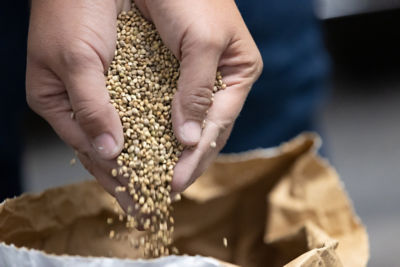Click here to download a PDF version of this spotlight.
» Soil nematodes can be detected and identified through soil testing.
» Periodic soil sampling can be used to monitor soil nematodes over time.
» Accurate nematode identification is useful when making management decisions.
Plant parasitic nematodes can cause substantial damage to vegetable crops resulting in reductions of yield potential. Most of the major nematode problems on vegetables are caused by soilborne species that feed on or in plant roots. The feeding can disrupt root functions, and affected plants can be stunted, chlorotic, and show delayed and reduced production. However, above-ground symptoms on nematode-affected plants are not distinctive enough to allow for an accurate diagnosis of the cause of the problem. Other factors that disrupt root function, such as root infecting fungi, as well as environmental factors - such as nutrient deficiencies, flooded soils, or drought conditions - can result in similar symptoms.1
Accurate diagnosis of nematode problems on vegetables usually requires the submission of soil and root samples to a plant diagnostic laboratory to determine the presence and population levels of specific types of plant parasitic nematodes. Knowing the types and levels of nematodes present can help growers choose appropriate resistant crop varieties, implement cultural practices to help lower nematode populations to decrease damage and help protect yields, and to determine if the application of nematicides is warranted.1,2 Periodic soil sampling and testing allows growers to monitor potential nematode problems in their fields over time.
 Figure 1. (A) Use a soil probe to collect soil from the top 8 to 12 inches. (B) Take samples from the root zone in the crop row. Iowa State University IPM program.
Figure 1. (A) Use a soil probe to collect soil from the top 8 to 12 inches. (B) Take samples from the root zone in the crop row. Iowa State University IPM program.
WHAT TO SAMPLE
Some plant parasitic nematodes are ectoparasitic, feeding on roots from the outside, while others are endoparasitic, embedding in the roots and feeding internally. Therefore, some nematodes can be easily extracted from the soil, while others are more easily found in root tissues. If you are not sure what specific nematode you want to detect and quantify, taking samples of both soil and root tissue will allow the samples to be tested for various kinds of nematodes. For example, root-knot nematodes are endoparasitic, feeding from within the root, and they are more likely to be detected from root tissue than from soil. The guidelines from many plant diagnostic labs indicate that root tissue and soil samples from an area should be placed in the same sample bag.1,3,4
 Figure 2. A “W” or zigzag pattern can be used when collecting samples from a field to help obtain a representative set of samples.
Figure 2. A “W” or zigzag pattern can be used when collecting samples from a field to help obtain a representative set of samples.
WHEN TO SAMPLE
The numbers of plant parasitic nematodes in the soil usually fluctuate over the course of the year/season. Therefore, the time of year/season that samples are collected can impact the nematode counts reported in the test results. For most plant nematodes, the population levels are highest near the time of harvest. Populations can quickly decline after harvest, and levels in the soil can be very low in the off-season. When sampling vegetable crop fields, it is often recommended that samples should be collected in mid-season or at the final harvest, when living roots are present and nematode populations are likely to be at their peak.1,2,3,4 Also, collect samples when soil conditions are suitable for fieldwork. Avoid collecting samples when soils are excessively wet or dry, as nematodes do not survive well under these conditions.
NUMBER OF SAMPLES TO COLLECT
Plant nematodes are not uniformly distributed in the soil or on plants in the field. Their distributions are usually clumped, with hot spots showing high numbers and other areas with low numbers of nematodes. Because of this non-uniformity, the accuracy of nematode testing (soil and tissue) increases with the number of samples tested. However, there is a cost for every sample tested. So, the number of samples submitted for testing needs to be reasonable. Recommendations for the number of samples to collect vary from lab to lab and also depend on the cropping system (grain crops, vegetable crops, turf, home garden). Collecting a bulk (soil/root) sample from each five- to ten-acre section of the field, with each bulk sample composed of at least 20 soil core subsamples, is often recommended for grain crops. For soil testing fields of highervalue vegetable crops, the University of Florida IFAS diagnostic lab recommends one bulk sample per acre with each bulk sample composed of at least ten soil core sub-samples.2,3,4
 Figure 3. Soil core subsamples are mixed to create a uniform bulk sample for the field section. Iowa State University IPM program.
Figure 3. Soil core subsamples are mixed to create a uniform bulk sample for the field section. Iowa State University IPM program.
HOW TO SAMPLE
For periodic monitoring of fields (testing every two to three years), divide the field into sections based on area (see above). Select sections that represent the different soil types, soil conditions (e.g. low, wet vs. high, dry), and cropping histories. If trying to diagnose a specific problem, then soil and root samples should be collected from areas where plants are showing moderately severe symptoms (poor growth) and from areas where plants appear to be healthy (good growth) for comparison. Avoid collecting samples from areas with dead plants, as this may result in low numbers of nematodes.1,3,4 Use a soil probe (Figure 1A) to collect 10 to 20 soil core subsamples from each section. Collect cores to a soil depth of eight to twelve inches. Some recommendations suggest removing the top inch or so of soil if that soil layer is dried out. Take the soil cores from within the crop row between plants to sample from the root zone (Figure 1B) and to collect both soil and root tissue.1,3 If collecting root samples specifically, not using a soil probe, do not pull the plants out of the ground, as the fine roots will remain in the soil. Use a spade or trowel and gently lift the plants out of the soil to retrieve the roots.4
Collect subsamples from randomly selected locations in the section (using a randomization scheme) or use a systematic sampling strategy, such as a zigzag pattern.1,4 Place the soil samples into a bucket or other container and mix them thoroughly to create a uniform bulk sample for the section (Figure 2). Depending on the requirements of the testing lab, take one to two pints of the mixed bulk sample and place it in a sturdy plastic bag, one bag for the bulk sample from each section. Seal the bag to prevent drying of the sample (Figure 3).1,2,3
 Figure 4. Bagged samples should be protected from overheating to preserve the viability of the nematodes in the sample. Iowa State University IPM program.
Figure 4. Bagged samples should be protected from overheating to preserve the viability of the nematodes in the sample. Iowa State University IPM program.
HANDLING AND SUBMITTING THE SAMPLES
After samples have been bagged, close or seal the bags to prevent drying. Do not add water to samples, even if they are dry. Label the outside of the bag with the sample number (or other identification), location, and date of sampling. Do not allow the samples to sit in direct sunlight or in hot vehicles, as heating the samples can reduce the viability of the nematodes. If possible, store the samples in an insulated cooler without ice (Figure 4). If the samples need to be stored for a day or two, store at 40 °F (refrigerated), until they can be sent for analysis.1,2,3,4
Take or ship samples to a plant diagnostic lab for testing. Include an information sheet with the sample with information such as the crop history of the field, current varieties being grown, soil types for the various samples, and any other information requested by the lab. If shipping, send the samples with express mail if possible. Avoid shipping later in the week so that samples will not sit in shipping facilities or vehicles over the weekend. Follow any additional guidelines provided by the testing lab.1,2,3,4
SOURCES
1Sikora, E., Conner, K., Gazaway, W., Hagan, A., and Mullen, J. 2019. Collecting soil and root samples for nematode analysis. Crop Production, Alabama A&M & Auburn Universities. https://www.aces.edu/blog/topics/crop-production/collecting-soil-root-samples-nematodeanalysis/.
2Bayer. 2023. Sampling for soil nematodes. https://www.cropscience.bayer.us/articles/dad/how-to-sample-soil-for-nematodes.
3Jagdale, G. and Arnold-Smith, L. 2011. Sampling for plant-parasitic nematodes identification and diagnosis. Department of Plant Pathology, University of Georgia. https://extension.uga.edu/content/dam/extension-county-offices/cobb-county/anr/NemaGuide4-2017%20(5).pdf.
4Nematode Assay Lab. 2019. Collecting nematode samples from commercially grown vegetables. University of Florida IFAS. https://entnemdept.ufl.edu/nematology-assay-lab/.
Websites verified 7/25/2024
ADDITIONAL INFORMATION
For additional agronomic information, please contact your local seed representative.
Performance may vary, from location to location and from year to year, as local growing, soil and environmental conditions may vary. Growers should evaluate data from multiple locations and years whenever possible and should consider the impacts of these conditions on their growing environment. The recommendations in this article are based upon information obtained from the cited sources and should be used as a quick reference for information about vegetable production. The content of this article should not be substituted for the professional opinion of a producer, grower, agronomist, pathologist and similar professional dealing with vegetable crops.
BAYER GROUP DOES NOT WARRANT THE ACCURACY OF ANY INFORMATION OR TECHNICAL ADVICE PROVIDED HEREIN AND DISCLAIMS ALL LIABILITY FOR ANY CLAIM INVOLVING SUCH INFORMATION OR ADVICE.
5011_437300 Published 08/07/2024




